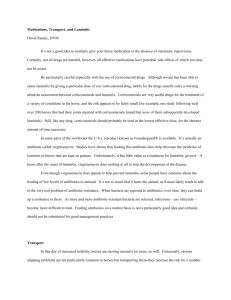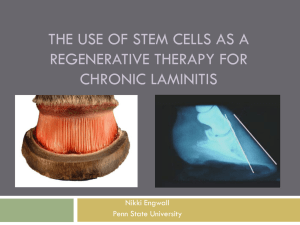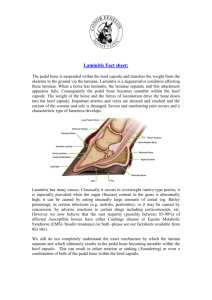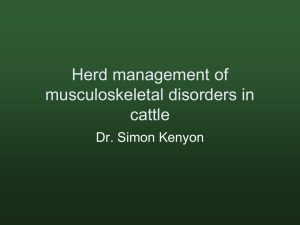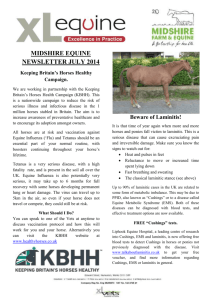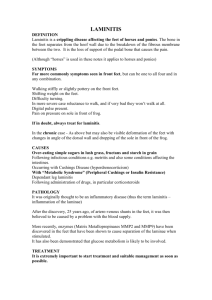solving acute equine laminitis with 94% clinical success rate
advertisement
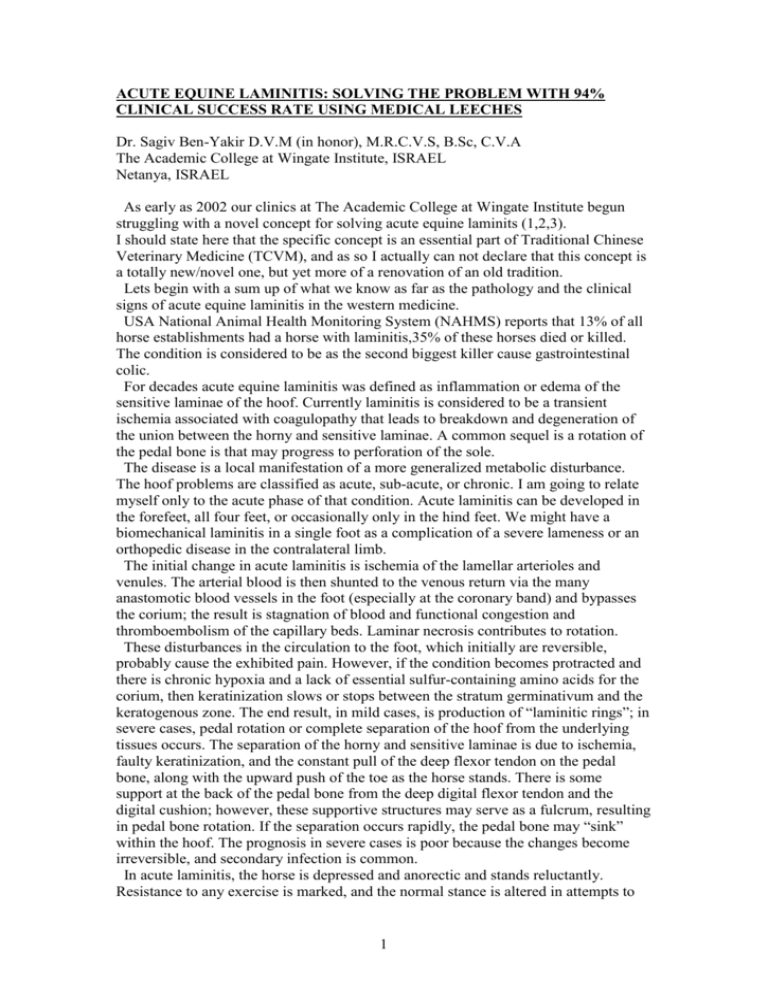
ACUTE EQUINE LAMINITIS: SOLVING THE PROBLEM WITH 94% CLINICAL SUCCESS RATE USING MEDICAL LEECHES Dr. Sagiv Ben-Yakir D.V.M (in honor), M.R.C.V.S, B.Sc, C.V.A The Academic College at Wingate Institute, ISRAEL Netanya, ISRAEL As early as 2002 our clinics at The Academic College at Wingate Institute begun struggling with a novel concept for solving acute equine laminits (1,2,3). I should state here that the specific concept is an essential part of Traditional Chinese Veterinary Medicine (TCVM), and as so I actually can not declare that this concept is a totally new/novel one, but yet more of a renovation of an old tradition. Lets begin with a sum up of what we know as far as the pathology and the clinical signs of acute equine laminitis in the western medicine. USA National Animal Health Monitoring System (NAHMS) reports that 13% of all horse establishments had a horse with laminitis,35% of these horses died or killed. The condition is considered to be as the second biggest killer cause gastrointestinal colic. For decades acute equine laminitis was defined as inflammation or edema of the sensitive laminae of the hoof. Currently laminitis is considered to be a transient ischemia associated with coagulopathy that leads to breakdown and degeneration of the union between the horny and sensitive laminae. A common sequel is a rotation of the pedal bone is that may progress to perforation of the sole. The disease is a local manifestation of a more generalized metabolic disturbance. The hoof problems are classified as acute, sub-acute, or chronic. I am going to relate myself only to the acute phase of that condition. Acute laminitis can be developed in the forefeet, all four feet, or occasionally only in the hind feet. We might have a biomechanical laminitis in a single foot as a complication of a severe lameness or an orthopedic disease in the contralateral limb. The initial change in acute laminitis is ischemia of the lamellar arterioles and venules. The arterial blood is then shunted to the venous return via the many anastomotic blood vessels in the foot (especially at the coronary band) and bypasses the corium; the result is stagnation of blood and functional congestion and thromboembolism of the capillary beds. Laminar necrosis contributes to rotation. These disturbances in the circulation to the foot, which initially are reversible, probably cause the exhibited pain. However, if the condition becomes protracted and there is chronic hypoxia and a lack of essential sulfur-containing amino acids for the corium, then keratinization slows or stops between the stratum germinativum and the keratogenous zone. The end result, in mild cases, is production of “laminitic rings”; in severe cases, pedal rotation or complete separation of the hoof from the underlying tissues occurs. The separation of the horny and sensitive laminae is due to ischemia, faulty keratinization, and the constant pull of the deep flexor tendon on the pedal bone, along with the upward push of the toe as the horse stands. There is some support at the back of the pedal bone from the deep digital flexor tendon and the digital cushion; however, these supportive structures may serve as a fulcrum, resulting in pedal bone rotation. If the separation occurs rapidly, the pedal bone may “sink” within the hoof. The prognosis in severe cases is poor because the changes become irreversible, and secondary infection is common. In acute laminitis, the horse is depressed and anorectic and stands reluctantly. Resistance to any exercise is marked, and the normal stance is altered in attempts to 1 relieve the weight borne by the affected feet. If forced to walk, the horse shows a slow, crouching, short-striding gait. Each foot, once lifted, is set down as quickly as possible. Usually, heat is apparent in the whole hoof, especially near the coronary band. An exaggerated and bounding pulse can be palpated and may be visible in the digital arteries. Pain can cause muscular trembling, and a fairly uniform tenderness can be detected when pressure is applied to the feet. The pedal bone may rotate during or after the acute stage if efficacious treatment is not given rapidly. Radiographic evidence of rotation can be present as early as the third day. The visible mucosae are often injected, with increased body temperature to 40-41°C, pulse rate of 80-120/min, and respiratory rate up to 80-100/min. In exceptionally severe cases, for which the prognosis is unfavorable, a blood-stained exudate may seep from the coronary bands. Sub-acute cases may exhibit any or all of the above clinical signs but to a lesser degree. Often, there is only a mild change in stance, with reluctance to walk and some increased sensitivity to concussion on the soles of the affected feet. There may be no demonstrable heat in the coronary band or increase in digital pulse. The acute and sub-acute forms of laminitis tend to recur at varying intervals and may develop into the chronic form. In acute and severe laminitis, diagnosis is based on the history (as grain overload) and posture of the horse, increased temperature of the hooves, a hard pulse in the digital arteries, and reluctance to move. Mild cases with no visible hoof deformity can be identified via radiography of the affected feet, which show a lack of parallelism on the lateral projection between the hoof wall and cranial face of the third phalanx. Divergence of ≥11° indicates a guarded to unfavorable prognosis for return to performance. Acute laminitis constitutes a medical emergency because pedal rotation can occur rapidly. Despite prompt therapy, the prognosis is guarded until recovery is complete and it is evident that the hoof architecture is not altered. I am not going into the therapeutic steps in western medicine here, the data can be found somewhere else. If one is into the knowledge of Traditional Veterinary Chinese Medicine (TCVM) he undoubtedly declares – ”WE HAVE HERE A CLASSICAL CASE OF A BLOOD STAGANTION”. What is Blood Stagnation? “Stagnation” means “a cessation of flowing or circulation”, or “not running in a current or a stream, not flowing; motionless”. Why the Blood is stagnated, or if you wish – what is the pathology of BLOOD STAGNATION? There are 10 different TCVM Blood Stagnation pathologies (as accumulation of Cold etc), but we are going to relate ourselves (due to time limit and the subject under discussion) only to one Pathogenic Heat: Dr. Zhang Zhong Jing put much of an emphasis on Blood Stagnation due to the accumulation of Pathogenic Heat, sourcing from external factors (as summer heat or infectious vector) or internal factors (internal toxins, emotions). What are the Clinical Signs of Blood Stagnation: Localized sharp and constant stabbing pain Pulse – choppy, regularly interrupted, deep or fine Tongue – purple spots/patches on tongue up to dark, brownish or engorged red tongue 2 Purplish/blue lips Bloody stool/urine with bleeding of dark purple/brown/black clotted blood Purple blood vessels in the eye’s sclera, bluish eyelids Pain worse at night Itching with discolored skin patches, lesions might be chronic and raised, also ulcerated, coat is withered and yellowish, nails withered and/or falling off, peeling of abdominal skin Hard, well-defined, immobile or fixed, possibly tender or painful lumps or masses, including organ enlargement, lumps/masses that may bleed Legs tremors, up to numbness or hemiplegia Variable energy level, tiredness better w/activity or movement, depression, moodiness, sighing Before moving on to the therapy – from “The Yellow Emperor’s Classic of Internal Medicine”: * ”If there is a Blood Stagnation it should be resolved by hemoacupuncture before any other acupuncture and/or moxibustion procedures” * “If stagnant blood is not moved, new blood can not be produced” * “Disease will not be developed into a critical condition if the Blood keeps flowing” So – when we find pattern of BLOOD STAGNATION we must treat it first before any routine or basic acupuncture or moxibustion. As we read in “The Yellow Emperor’s Classic of Internal Medicine” we can understand the theories on the mechanisms behind the therapeutic effects of the so needed hemo-acupuncture as the first therapeutic task to be done by the therapist: Direct effects: 1.Frees the flow of Qi 2.Resolves Blood Stasis 3.Clears Blood-Heat 4.Releases toxicity Indirect effects: 1.Supplements Qi 2.Nourishes and regenerates Blood 3.Extinguishes Wind 4.Calms the Shen & promotes sleep Also – one should keep in mind some contra-indications before moving into bloodletting therapy: Coagulopathy or animal on anti-coagulant therapy Anemia and/or low blood pressure Last stages of malignant tumor Pregnant animal Bleeding in estrus time So what points do we bleed? 1) local & painful points 2) distal & proximal points of the affected meridian 3) Ting points for specific problems according to the affected zang fu organ/meridian 4) LIV points (LIV-02/03/14), BL-18, GB-34 to move Qi & Blood 5) HT points to benefit HT function of controlling Blood 3 6) Empirical points - BL-17, SP-10, SP-08 7) Around the ears pts (for head issues) 8) GV-14 for pink eye, conjunctivitis, retinal atrophy 9) GB-21, TH-15 for stiff neck/shoulders 10) LI-15, TH-14 head-skin disorders 11) Between shoulder blades for chronic gastritis & respiratory issues as asthma & bronchitis 12) Uro-genital issues or mastitis – inguinal area Dr. Zhang Zhong Jing (150-219 A.D) wrote in Golden Chamber of Jade Palaces Channels: “Medical leeches are the best equipped creatures in our globe to locate Excess, especially Excess with Blood Stagnation. It is due to the fact that all their existence is about locating the points in Excess, and be able to get an easy way to harvest blood ”. Dr. Zhang Zhong Jing was one of the most well known & be-loved Chinese physicians who wrote two classics – Shang Han Lun, discussion of cold induced disease, and Jing Gui Yao Lun, Synopsis of Prescriptions of the Golden Chamber. These works are still used today for the diagnosis & treatment. He is the founder of the Blood Stagnation Theory. In Chinese - medical leeches are named “ Shui zhi ”. As mentioned before – they considered to quicken Xue (Blood), resolve Xue Stagnation, and resolve Qi Stagnation. They are to be put on acupuncture points. Can also be found as a baked powder and has to be taken orally as part of herbal remedy - 0.3 – 0.6 grams once a day for as long as needed. Additional benefits that are mentioned - due to the bacteriostatic and anesthetic abilities of the medical leeches, we can apply them to an acupoint or a tissue to be treated that is infectious and heavily contaminated area, and also a very painful area. As the worm bites, it injects a complex cocktail of proteins into the host through its saliva, which are responsible for the therapeutic effects as well. The saliva contains Hirudin, a potent anticoagulant that consists of 65 amino acids. Hirudin inhibits the conversion of fibrinogen to fibrin by inhibiting thrombin & preventing blood from clotting. Hirudin also inhibits platelets aggregation. Hirudin works in conjunction with a vasodilator, one that increases the diameter of blood vessels by relaxing the smooth muscle of the blood vessels, to widen the diameter of the vessel and increase the flow of blood and by that promotes blood flow. The leech’s vasodilator is a histamine-like substance. The effectiveness of this therapy is not simply due to enhanced blood flow, but because bleeding from a bite may continue as long as 10 hours, relieving tissue congestion mainly due to venous insufficiency, in areas where arterial flow is maintained but venous return is severely compromised, till collateral circulation reestablishes sufficient venous return in four to five days. The frequency of the therapeutic sessions can vary from once a day for a few consecutive days to once every couple of weeks. There are at least two other documented molecules (destabilase & hyaluronidase) that help breaking apart any fibrin fibers & and local connective tissue and by that facilitate continual blood oozing from the leech’s wound. An added benefit is that leech saliva contains a local morphine-like analgesic substance, allowing a painless attachment and feeding. Because of the saliva's effects, an animal bitten by a leech may not even be aware of it until afterwards. Leech’s saliva contains also natural bacteriostatic component, as well as some regenerating and immunomodulatory substances. The saliva contains at least one anti-inflammatory molecule called leech-derived tryptase inhibitor. 4 The Wingate Institute Acute Equine Laminitis Protocol: To be done on horses only in their first 24 hours (the therapeutic window) with acute laminitis 1) Shave the coat proximal to the affected hooves. 2) Wet the affected legs with lots of non-chlorinated cold water. 3) Using acupuncture needle – puncture the 6 Jing-Well/Ting points of each of the affected leg/s, and apply 2 leeches on each of the points. 4) Also add 6 more leeches - each one of them on a proximal acupuncture point of the different 6 meridians. 5) Therapy is done every 12 hours for two days. This protocol was done on 36 diagnosed horses with acute laminitis in their first 24 hours. 34 (94%) of these horses became “a normal walker” within 36 hours after beginning of therapy. Why leeches are doing “the magic” as far as western medicine? They work on the blood vessels issue (see before), but also – The lamellar basement membrane in affected horses is separated and lysed by proteinases, leading to pedal bone separation and rotation – but - leeches release inhibitory enzymatic proteins (as Eglin C, Hirudin) that stop the proteinases activities, and by that arrest the separation and rotation. Also – followed my work – a study (4) was done in Germany from May 2008 to August 2009 by the German Hoof Orthopaedic Society (Deutsche Huforthopädische Gesellschaft e. V.) with the objective to investigate the efficacy of hirudotherapy in treating laminitis. The data was collected from 112 bloodsucker applications in 57 laminitic horses. In 84 % of the cases, evidence of improvement in the clinical symptoms was noticeable after the application of hirudotherapy. The study results vividly show that the use of bloodsuckers in the treatment of laminitis comprises of meaningful therapy measures especially for acute cases. If you remember – in our own work – the clinical success rate is 94%, but here (German study) – only 84%…Why? Because in our study we did only on acute laminitis, and in the German study they had also a few chronic cases that did not yield successes - if you remove the chronic cases from the calculation– you’ll get 94%. References: 1) ”Bio-Zoo-Acupuncture” in Veterinary Acupuncture Newsletter, Vol 26, #3, p 7, Aug 2003, also in Proceedings of the 30th Annual International Congress on Veterinary Acupuncture, sponsored by The International Veterinary Acupuncture Society (I.V.A.S), Sept 2004, pp 257-260. 2) ”Veterinary Hirudotherapy (VHT) or The Therapy That Sucks” in Journal of the American Holistic Veterinary Medical Association, Vol 24, #1, pp 11-18, April-June 2005. 3) ”Veterinary Hirudotherapy & Equine Laminitis” in THE BeTER LeTTER, Vol 2, #2, Fall 2005. Biotherapeutics, education & research foundation, Irvine, CA, USA. 4) “Blutegeltherapie bei Hufrehe der Pferde Ergebnisse einer bundesweiten Studie” or – “Veterinary hirudotherapy for horse laminitis results of a nationwide study in Germany” by Dr. Konstanze Rasch. 5 Zeitschrift für Ganzheitliche Tiermedizin 2010; 24(1):92-92 6
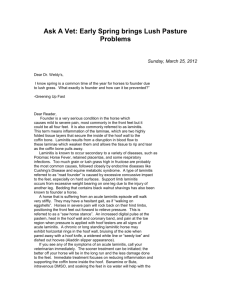

![founder [foun-der] * verb](http://s3.studylib.net/store/data/006663793_1-d5e428b162d474d6f8f7823b748330b0-300x300.png)
